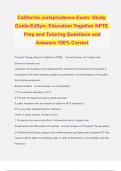Exam (elaborations)
Test Bank For Lewis's Medical-Surgical Nursing, 12th Edition by Mariann M. Harding, Jeffrey Kwong, Debra Hagler Chapter 1-69
Test Bank For Lewis's Medical-Surgical Nursing 12th Edition by Mariann M. Harding, Jeffrey Kwong, Debra Hagler Chapter 1-69 Complete Guide A+ SECTION 1 Concepts in Nursing Practice Chapter 1 Professional Nursing Chapter 2 Social Determinants of Health Chapter 3 Health History and Physical Examinati...
[Show more]












